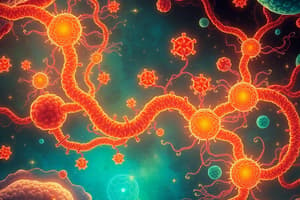Podcast
Questions and Answers
What is the primary function of glycolysis in cellular respiration?
What is the primary function of glycolysis in cellular respiration?
- To break down sugar and produce ATP (correct)
- To produce glucose
- To synthesize oxygen
- To oxidize pyruvate
Which of the following is NOT an input for glycolysis?
Which of the following is NOT an input for glycolysis?
- Glucose
- 2 FADH2 (correct)
- 2 NAD+
- 2 ATP
What are the products of glycolysis?
What are the products of glycolysis?
- 2 Pyruvate, 2 ATP, and 2 NADH (correct)
- 1 Glucose and 4 ADP
- 4 Pyruvate and 2 ATP
- 2 NAD+ and 2 ATP
Where does the glycolysis process take place within the cell?
Where does the glycolysis process take place within the cell?
What is the role of NAD+ in glycolysis?
What is the role of NAD+ in glycolysis?
Which statement accurately describes endergonic reactions?
Which statement accurately describes endergonic reactions?
What is the primary purpose of adenosine triphosphate (ATP) in cellular respiration?
What is the primary purpose of adenosine triphosphate (ATP) in cellular respiration?
In the context of cellular respiration, which of the following is a product of the reaction ADP + Pi?
In the context of cellular respiration, which of the following is a product of the reaction ADP + Pi?
Which of the following is a direct result of utilizing ATP in muscle contraction?
Which of the following is a direct result of utilizing ATP in muscle contraction?
What role do exorganic reactions play in relation to endergonic reactions?
What role do exorganic reactions play in relation to endergonic reactions?
What is the primary role of the Rubisco enzyme in the Calvin cycle?
What is the primary role of the Rubisco enzyme in the Calvin cycle?
How many carbon atoms are fixed during one complete cycle of the Calvin cycle?
How many carbon atoms are fixed during one complete cycle of the Calvin cycle?
Which molecule serves as the initial stable product formed when CO₂ is fixed in the Calvin cycle?
Which molecule serves as the initial stable product formed when CO₂ is fixed in the Calvin cycle?
What is the total number of ATP molecules required in the regeneration phase of the Calvin cycle for glucose synthesis?
What is the total number of ATP molecules required in the regeneration phase of the Calvin cycle for glucose synthesis?
What is NOT an input required for the Calvin cycle to function?
What is NOT an input required for the Calvin cycle to function?
Which component is primarily responsible for capturing light energy in the light-dependent reactions of photosynthesis?
Which component is primarily responsible for capturing light energy in the light-dependent reactions of photosynthesis?
What is the primary purpose of the light-independent reactions in photosynthesis?
What is the primary purpose of the light-independent reactions in photosynthesis?
Which of the following wavelengths is most efficiently absorbed by chlorophyll A?
Which of the following wavelengths is most efficiently absorbed by chlorophyll A?
What happens when a photon of light strikes an electron in a photosynthetic pigment molecule?
What happens when a photon of light strikes an electron in a photosynthetic pigment molecule?
Where do the light-dependent reactions take place in photosynthetic eukaryotes?
Where do the light-dependent reactions take place in photosynthetic eukaryotes?
Which type of light is not visible and can generate heat?
Which type of light is not visible and can generate heat?
What is the main outcome of the reaction in photosynthesis represented by the equation 6H₂O + 6CO₂ → C₆H₁₂O₆ + 6O₂?
What is the main outcome of the reaction in photosynthesis represented by the equation 6H₂O + 6CO₂ → C₆H₁₂O₆ + 6O₂?
In the context of light absorption, what does the absorption spectrum illustrate?
In the context of light absorption, what does the absorption spectrum illustrate?
What is the total estimated ATP yield from one glucose molecule during cellular respiration after correction?
What is the total estimated ATP yield from one glucose molecule during cellular respiration after correction?
Which process is primarily responsible for ATP production in the absence of oxygen?
Which process is primarily responsible for ATP production in the absence of oxygen?
What happens to NAD+ availability if the electron transport chain cannot function due to a lack of oxygen?
What happens to NAD+ availability if the electron transport chain cannot function due to a lack of oxygen?
In alcoholic fermentation, what is produced from the conversion of pyruvate?
In alcoholic fermentation, what is produced from the conversion of pyruvate?
During which stage of cellular respiration are the majority of NADH molecules generated?
During which stage of cellular respiration are the majority of NADH molecules generated?
What is the primary output of pyruvate oxidation?
What is the primary output of pyruvate oxidation?
During the Krebs cycle, what molecule is generated from Acetyl CoA and Oxaloacetic Acid?
During the Krebs cycle, what molecule is generated from Acetyl CoA and Oxaloacetic Acid?
What is the first step in oxidative phosphorylation?
What is the first step in oxidative phosphorylation?
What is the final product when FADH2 is utilized in the electron transport chain?
What is the final product when FADH2 is utilized in the electron transport chain?
In the Krebs cycle, what is the result of breaking down complex molecules?
In the Krebs cycle, what is the result of breaking down complex molecules?
What is the primary function of ATP synthase in the photosynthetic process?
What is the primary function of ATP synthase in the photosynthetic process?
Which of the following represents a key difference between cyclic and non-cyclic photophosphorylation?
Which of the following represents a key difference between cyclic and non-cyclic photophosphorylation?
What is the source of electrons in the process of non-cyclic photophosphorylation?
What is the source of electrons in the process of non-cyclic photophosphorylation?
Which photosystem is associated with eukaryotes and plays a role in non-cyclic photophosphorylation?
Which photosystem is associated with eukaryotes and plays a role in non-cyclic photophosphorylation?
What significant atmospheric change is marked by the Great Oxidation Event?
What significant atmospheric change is marked by the Great Oxidation Event?
Which of the following is a byproduct of the splitting of water during photosynthesis?
Which of the following is a byproduct of the splitting of water during photosynthesis?
What happens to protons ($H^+$) during the light-dependent reactions of photosynthesis?
What happens to protons ($H^+$) during the light-dependent reactions of photosynthesis?
Cyanobacteria are primarily associated with which form of photophosphorylation?
Cyanobacteria are primarily associated with which form of photophosphorylation?
What is true about the relationship between potential energy and order in a system?
What is true about the relationship between potential energy and order in a system?
Which factor primarily influences the activation energy required for achieving an exergonic reaction?
Which factor primarily influences the activation energy required for achieving an exergonic reaction?
How do coenzymes affect enzyme activity?
How do coenzymes affect enzyme activity?
In the context of energy diagrams, what does an exergonic reaction graphically demonstrate?
In the context of energy diagrams, what does an exergonic reaction graphically demonstrate?
What is the role of the active site in enzyme function?
What is the role of the active site in enzyme function?
What is the main energy storage advantage of fats compared to glucose?
What is the main energy storage advantage of fats compared to glucose?
Which mechanism is primarily used by mammals to safely excrete ammonia resulting from amino acid metabolism?
Which mechanism is primarily used by mammals to safely excrete ammonia resulting from amino acid metabolism?
In which metabolic regulation mechanism does the product inhibit its own formation?
In which metabolic regulation mechanism does the product inhibit its own formation?
What is the fate of excess amino acids after deamination occurs?
What is the fate of excess amino acids after deamination occurs?
How does the transport mechanism for fats differ from that of glucose?
How does the transport mechanism for fats differ from that of glucose?
What happens to blood glucose when it is not utilized immediately after a meal?
What happens to blood glucose when it is not utilized immediately after a meal?
Which group of animals directly excretes ammonia, allowing it to diffuse easily?
Which group of animals directly excretes ammonia, allowing it to diffuse easily?
Which metabolic process primarily involves the conversion of Acetyl CoA to generate energy?
Which metabolic process primarily involves the conversion of Acetyl CoA to generate energy?
What characteristic of uric acid makes it particularly beneficial for reptiles and birds?
What characteristic of uric acid makes it particularly beneficial for reptiles and birds?
What is the primary reason for feedback inhibition in metabolic pathways?
What is the primary reason for feedback inhibition in metabolic pathways?
Flashcards are hidden until you start studying
Study Notes
Cell Metabolism
- Energy obeys two laws of thermodynamics:
- Energy cannot be created or destroyed, it can only be transformed.
- Closed systems will increase entropy (chaos) over time.
- Two forms of energy:
- Potential energy - energy stored in systems (function of order).
- Kinetic energy - energy in the process of doing work.
Energy Diagrams
- Illustrates energy changes during a reaction.
- Example: AB → A + B
- AB: Higher potential energy (PE), more order.
- A + B: Lower potential energy (PE), less order.
- Activation Energy: The energy required to initiate the reaction (the hill).
- Exergonic Reaction: The reaction releases energy (Energy decreasing process).
Two Ways to Initiate an Exergonic Reaction
- Increase Temperature: Increasing the temperature increases the kinetic energy of molecules, making it more likely that they will overcome the activation energy barrier.
- Use Enzymes: Enzymes lower the activation energy required for a reaction to proceed.
Enzyme Action
- Active Site: The part of an enzyme that binds to the substrate (reactant).
- Active Site Affinity: How tightly the active site binds to the substrate.
- Enzyme-Substrate Complex: The complex formed when an enzyme binds to its substrate.
- Shape Changes: Enzymes undergo a conformational change upon substrate binding.
- Coenzymes: Non-protein organic molecule required for enzyme activity.
Studying That Suits You
Use AI to generate personalized quizzes and flashcards to suit your learning preferences.




